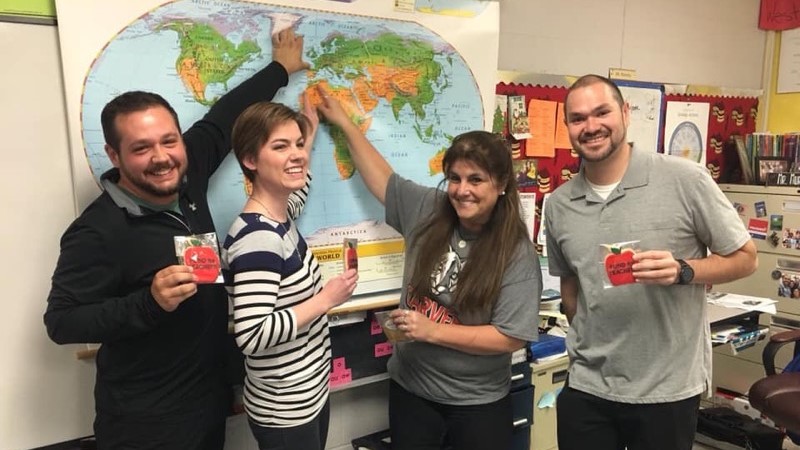Fellow Friday | Speaking Their Language

Each Friday throughout the summer, we are highlighting one of our 2019 Fellows — their inspiration, itinerary, and plan for transforming student learning going forward. Today, we highlight our first team, which named themselves “Spainward Bound.” Erin Strack, Andrew Murphy, Juan Carlos Lara and Pato Cabral will use their $10,000 Fund for Teachers grant to attend the International Colloquium on Languages, Culture, and Identity in Schools and Society in Soria, Spain, this summer. Because they work at a dual language school in Kansas City, they designed this fellowship to address topics in the forefront of dual language educational practices and inform a new Spanish/English poetry unit inspired by Spanish architecture and landscapes.
Why This Experience?
We’re an urban elementary school (grades K-6) with a population of about 80% Latino students, the remaining 20% being mainly comprised of African American students. While being part of such a unique form of education is engaging and rewarding, it can also be frustrating and confusing at times:
- We say frustrating because our student population has very different needs than the typical student population of a monolingual school, yet we’re expected to instruct, assess, and perform according to the same rigid guidelines put in place for those monolingual programs, and our students’ test scores are measured by the same district-wide metric used for their monolingual peers.
- We say confusing because there aren’t a whole lot of schools like ours out there, especially given our geographical location. We’re one of only a handful in our state, so finding relevant professional development opportunities, appropriate classroom resources, and effective instructional practices can be extremely challenging.
 There simply aren’t enough teacher education agencies in the US that can appropriately train and prepare teachers how to competently teach both English and Spanish literacy simultaneously.
There simply aren’t enough teacher education agencies in the US that can appropriately train and prepare teachers how to competently teach both English and Spanish literacy simultaneously.
- Having the opportunity to attend sessions on effective bilingual teaching practices presented by people who have more knowledge and experience in dual language education than anyone we could find in the US will be immensely beneficial to our program, our teachers, and most importantly our students.
- There are also many sessions on identifying culturally as a bilingual child in society and how “living in two worlds” can be as equally enlightening as it is alienating. We hope to learn how to better support our students with this unique cultural identification.
- Finally, we anticipate networking with authors and booksellers at the conference and around the city, in order to obtain authentic Spanish literacy resources to take back to our classrooms.
The Planned Itinerary
The Colloquium will highlight topics that are in the forefront of dual language educational practices. When not in sessions, we’ll scour the city of Soria for natively written literature for both children and adults. There is a huge need for Spanish books in content areas such as science, as well as fiction books and comics. Most of our Spanish teachers have to create much of their content area resources themselves, as it’s next to impossible to find this variety of resources in the US.
Upon completion of the Colloquium, we’ll explore the Casa de los Poetas, which describes the lives and works of three famous Spanish poets. We also plan to visit the nearby village of Calatanazor, which was a location for Orson Wells’ Chimes at Midnight, and Agreda,
the village of three cultures: Arabic, Jewish, and Christian. In visiting these local points of interest, we can enliven our classroom teaching with vivid descriptions of Spain’s history, architecture, and natural beauty.

Panoramic view of Calatanazor (courtesy of sorianitelaimaginas.com)
Plans for Students
 Our team consists of a 5th/6th grade Spanish math teacher, a 4th grade Spanish literacy teacher, a 3rd grade English literacy teacher and literacy coach, and an ESL teacher that co-teaches in 3rd and 4th grade. Working collaboratively, we’ll use our newly learned strategies and newly acquired resources to create a Spanish/English poetry unit. This would include author studies, poetry reading and writing, and shared presentations of written poetry. Both 3rd and 4th grade have poetry standards that have been notoriously
Our team consists of a 5th/6th grade Spanish math teacher, a 4th grade Spanish literacy teacher, a 3rd grade English literacy teacher and literacy coach, and an ESL teacher that co-teaches in 3rd and 4th grade. Working collaboratively, we’ll use our newly learned strategies and newly acquired resources to create a Spanish/English poetry unit. This would include author studies, poetry reading and writing, and shared presentations of written poetry. Both 3rd and 4th grade have poetry standards that have been notoriously
tricky to cover in Spanish. None of the nuances of poetry that make it so beautiful (rhythm, imagery, descriptive language, word play) can be translated well, so finding famous poems written in English and then translating them is not an option. This fellowship would provide our students with this brilliant new learning opportunity, to engage in a linguistically balanced poetry study unit.
Closing Thoughts
We’re incredibly grateful for the opportunity to attend the colloquium on dual language education in Spain. The knowledge, experiences, and resources we expect to return with are beyond measure. Our colleagues are equally excited, as we’re all well aware of the positive and direct impact this fellowship will have on our students and school community as a whole. We’re deeply honored, and of course, more than a little excited!
 Back to Blogs
Back to Blogs